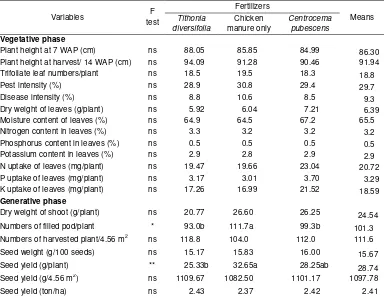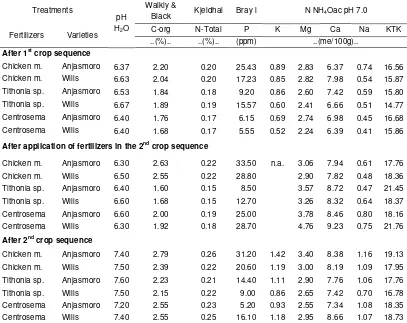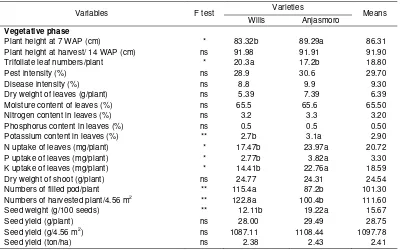Organically Production of Soybean Supported by Fertilizers Residue under
Saturated Soil Culture
Maya Melati
a,*, Kalimatul Jumro
aa Department of Agronomy and Horticulture, Faculty of Agriculture, Bogor Agricultural University, Indonesia * Corresponding author: Department of Agronomy and Horticulture, Faculty of Agriculture,
Bogor Agricultural University (IPB).
Jl. Meranti, Kampus IPB Darmaga, Bogor 16680, Indonesia. Tel.: +62 251 8629353; fax: +62 251 8629353.
Abstract
Organic farming system can use natural on-farm inputs that are normally available at the production site. Saturated Soil Culture (SSC) is a technology in cultivation that gives water permanently, maintains and keeps its depth constantly; this makes soil layer in saturated condition. SSC technology can be implemented in land with poor drainage or in cultivating soybean on rice field in the period between two rice plantings when the soils may still be in water saturated conditions. The experiment was conducted to study the response of two soybean varieties to the residues of different types of fertilizer in an organic farming system. The experiment was carried out at IPB experimental station, Bogor, Indonesia, in October 2010-February 2011. Split plot design was used with types of fertilizer as the main plot (chicken manure, Centrosema pubescens Benth, and Tithonia diversifolia Hemsl.) and soybean varieties as the sub plot (Anjasmoro and Wilis). To study the effectiveness of fertilizers residue, the current experiment applied 50% fertilizer rates (10 t chicken manure only/ha, 5 t chicken manure mixed with 2.1 t C. pubescens/ha, and 5 t chicken manure with 2.1 t T. diversifolia/ha) of those applied in the previous soybean planting (May-August 2010). The results showed that chicken manure yielded the highest seed weight and filled pod number per plant. However, seed yields per hectare were not affected by fertilizer types. The soybean plant with the application of chicken manure, C. pubescens, and T. diversifolia produced 2.37, 2.42, and 2.43 t seed/ha, respectively. Wilis had higher number of filled pod per plant than Anjasmoro, but the yields per hectare of both varieties were not different. Production of Anjasmoro and Wilis was 2.43 and 2.38 t/ha, respectively.
Keywords: Centrosema pubescens Benth, chicken manure, Glycine max (L.) Merr., green manure, Tithonia diversifolia Hemsl
Introduction
National demand on soybean is about 2.2 million tons per year, but only 35-40% of this
demand can be supplied from the domestic production, and the government has to import about 1.3
t soybean/year. Low productivity, decreasing agricultural land area, and limited access of farmers to
technology and funding, are some of the factors restricting the national production of soybeans.
Organic farming is an alternative to currently used methods of farming; its use might
increase soybean production. Currently the marketing of produce from organic farms is targeted
only at consumers who are interested in it because they view it as being healthier. However,
organic farming systems could be useful to farmers who have limited access to production inputs
(e.g. inorganic fertilizers and pesticides) and funds. Because of the presumed lower productivity of
organic systems as opposed to conventional farming the ability of organic systems to support food
security is questioned; nevertheless organic farming may be able to provide local food security.
Farmers can use on-farm inputs normally available to them on the site of production.
pubescens
, and
Crotalaria juncea
, rock phosphate, charcoal and ash or rice hull (Barus, 2005;
Melati and Andriyani, 2005; Sinaga, 2005; Kurniasih, 2006). Some of those organic fertilizers had
resulted significant differences in plant performances, but not in production.
The experiment had
also been conducted to produce dry seed of soybean to investigate whether organic farming system
supported plant production not only at less mature seed but also at fully mature stage. Kurniansyah
(2010) found that chicken manure only or its combination with green manure produced dry seed of
1.16-1.48 t/ha on upland, while Ramadhani (2011) found that soybean yield was 1.83-1.94 t/ha on
soil with saturated soil culture technology
.
Saturated Soil Culture (SSC) is a technology in cultivation that gives water permanently,
maintains and keeps its depth constantly (about 5 cm under soil surface); this makes soil layer in
saturated condition. In saturated soil culture, watering is started from the beginning of plant growth
to maturity stage (Hunter
et al.,
1980). By keeping the water-table constantly, soybean will be
avoided from negative effect of inundation on soybean growth, because soybean will acclimatize
and improve its growth (Troedson
et al.
, 1983). Ghulamahdi (2007) found that under SSC, growth
and production of soybean was improved related to the increase of ACC, ethylene, glucose content,
and neck diameter of roots, and the increase of nodules‘ weight, nitrogenase activity, and nutrient
uptakes. SSC technology can be implemented in land with poor drainage or in cultivating soybean
on rice field in the period between two rice plantings where the soils may still be in water saturated
conditions. Ghulamahdi
et al.
(2009) also showed that SSC can be implemented in cultivating
soybean in tidal swamp area with the production of more than double of those in upland.
The availability of nutrient provided by organic fertilizers is not as quick as from inorganic
fertilizers; this may result in available nutrient in the following cropping season. Melati
et a
l. (2008)
showed that the residue of fertilizers supported the production of organic vegetable soybean on
upland soil. The current experiment studied the possibilities of producing dry seed of soybean with
the residue of fertilizers under SSC technology. Two types of soybean cultivar (they differ in seed
sizes) were used to investigate their responses to the treatments.
Materials and Methods
A field study was conducted in October 2010-February 2011 at the Cikarawang
Experiment Station of Bogor Agricultural University (IPB), in Bogor, Indonesia. The soil is a silty clay
loam soil
.
The experiment was the second crop sequence. The experimental design was a
randomized complete block with spilt plot arrangement and three replicates. Types of fertilizer
included in the study were chicken manure only (10 t/ha), chicken manure combined with
Centrosema pubescens
(5 + 2.1 t/ha), and chicken manure combined with
Tithonia diversifolia
(5 +
2.1 t/ha) were considered as main plots, and assigned to an area of 4 x 4 m. Subplots were
assigned within each main plot, each differing by soybean cultivar, i.e. Anjasmoro and Wilis.
Subplots dimensions were five 4-m long rows spaced 0.4 m apart and 0.1 m apart within row.
Those fertilizer rates were half of rates in the first crop sequence to evaluate the
effectiveness of fertilizers residue. In the first crop sequence, the rate of chicken manure was
applied at the rate of 20 t/ha followed Sinaga (2005) and the rates of green manure biomass was
determined based on a study of Kurniasih (2006). It was expected that a yield of about 10 t
biomass/ha
was obtained
from 25 kg seed of
C. pubescens.
However, dry conditions during the
growth period of
C. pubescens
. (December 2009-April 2010)
resulted in the production of only 3.5 t
rice hull charcoal and dolomite) was applied 2 weeks before soybean planting. All materials were
applied in planting rows; they were then below the position of soybean seed.
SSC technique was conducted by providing water permanently since 4 weeks after
planting (WAP), maintained and kept water depth constantly at about 5 cm under soil surface in
20-cm depth furrow. Ghulamahdi (2007)
found that plants normally experience chlorosis in saturated
soil, therefore, in the current experiment liquid manure (1 L liquid manure/10 L water) was added as
foliar application to the plants at the 3
rd, 5
th, and 7
thday after irrigation began.
Other cultural practices were seed treatment by using
Rhizobium
inoculants with the rate
of 6.25 g/kg seed, and the planting of
Tagetes erecta
and
Cymbopogon nardus
near soybean plants
to control plant pest and diseases.
Tagetes erecta
and
Cymbopogon nard
us had been used in
producing organic vegetable soybean (Kusheryani and Aziz, 2006).
Analysis of variance was used to analyze the data and Duncan
‘
Multiple Range Test
(DMRT) was used to compare means value.
Results and Discussion
[image:3.499.60.444.336.634.2]
Plant characters as shown in vegetative phase and yield component in generative phase
were not different among fertilizer types. Variables were only different in number of filled pod and
seed yield per plant with the highest values were in plants with the application of chicken manure
only. Since the number of harvested plant in plot with chicken manure only was lower than those
with other fertilizers, seed yields per hectare were not different among treatments (Table 1).
Table 1. Plant characters and production with three types of fertilizer
Variables F
test
Fertilizers
Means Tithonia
diversifolia
Chicken manure only
Centrocema pubescens
Vegetative phase
Plant height at 7 WAP (cm) ns 88.05 85.85 84.99 86.30
Plant height at harvest/ 14 WAP (cm) ns 94.09 91.28 90.46 91.94 Trifoliate leaf numbers/plant ns 18.5 19.5 18.3 18.8
Pest intensity (%) ns 28.9 30.8 29.4 29.7
Disease intensity (%) ns 8.8 10.6 8.5 9.3
Dry weight of leaves (g/plant) ns 5.92 6.04 7.21 6.39 Moisture content of leaves (%) ns 64.9 64.5 67.2 65.5
Nitrogen content in leaves (%) ns 3.3 3.2 3.2 3.2
Phosphorus content in leaves (%) ns 0.5 0.5 0.5 0.5
Potassium content in leaves (%) ns 2.9 2.8 2.9 2.9
N uptake of leaves (mg/plant) ns 19.47 19.66 23.04 20.72
P uptake of leaves (mg/plant) ns 3.17 3.01 3.70 3.29
K uptake of leaves (mg/plant) ns 17.26 16.99 21.52 18.59
Generative phase
Dry weight of shoot (g/plant) ns 20.77 26.60 26.25 24.54
Numbers of filled pod/plant * 93.0b 111.7a 99.3b 101.3
Numbers of harvested plant/4.56 m2 ns 118.8 104.0 112.0 111.6
Seed weight (g/100 seeds) ns 15.17 15.83 16.00 15.67
Seed yield (g/plant) ** 25.33b 32.65a 28.25ab 28.74
Seed yield (g/4.56 m2) ns 1109.67 1082.50 1101.17 1097.78
Seed yield (ton/ha) ns 2.43 2.37 2.42 2.41
Seed yield per plant may be related to the soil nutrient content. After the 1
stcrop season,
C-organic, N-total, available P and K were higher in plots with the application of chicken manure
only compared to those with other fertilizer treatments. These conditions were also detected in the
2
ndcrop sequence before soybeans were planted (Table 2). The amount of nutrients in the soil with
chicken manure application had supported the seed yield of single plant.
Table 2. Soil characteristics
Treatments
pH H2O
Walkly &
Black Kjeldhal Bray l N NH4Oac pH 7.0
Fertilizers Varieties C-org N-Total P K Mg Ca Na KTK
..(%).. ..(%).. (ppm) ..(me/100g)..
After 1st crop sequence
Chicken m. Anjasmoro 6.37 2.20 0.20 25.43 0.89 2.83 6.37 0.74 16.56
Chicken m. Wilis 6.63 2.04 0.20 17.23 0.85 2.82 7.98 0.54 15.87
Tithonia sp. Anjasmoro 6.53 1.84 0.18 9.20 0.86 2.60 7.42 0.59 15.80
Tithonia sp. Wilis 6.67 1.89 0.19 15.57 0.60 2.41 6.66 0.51 14.77
Centrosema Anjasmoro 6.40 1.76 0.17 6.15 0.69 2.74 6.98 0.45 16.68
Centrosema Wilis 6.40 1.68 0.17 5.55 0.52 2.24 6.39 0.41 15.86
After application of fertilizers in the 2nd crop sequence
Chicken m. Anjasmoro 6.30 2.63 0.22 33.50 n.a. 3.06 7.94 0.61 17.76
Chicken m. Wilis 6.50 2.55 0.22 28.80 2.90 7.82 0.48 18.36
Tithonia sp. Anjasmoro 6.40 1.60 0.15 8.50 3.57 8.72 0.47 21.45
Tithonia sp. Wilis 6.60 1.68 0.15 12.70 3.26 8.32 0.64 18.37
Centrosema Anjasmoro 6.60 2.00 0.19 25.00 3.78 8.46 0.80 18.16
Centrosema Wilis 6.30 1.92 0.18 28.70 4.76 9.23 0.75 21.76
After 2nd crop sequence
Chicken m. Anjasmoro 7.40 2.79 0.26 31.20 1.42 3.40 8.38 1.16 19.13
Chicken m. Wilis 7.50 2.39 0.22 20.60 1.19 3.00 8.19 1.09 17.95
Tithonia sp. Anjasmoro 7.60 2.23 0.21 14.40 1.11 2.90 7.76 1.06 17.76
Tithonia sp. Wilis 7.50 2.15 0.22 9.00 0.86 2.65 7.42 0.70 16.78
Centrosema Anjasmoro 7.20 2.55 0.23 5.20 0.93 2.55 7.34 1.08 18.35 Centrosema Wilis 7.40 2.55 0.25 16.10 1.18 2.95 8.66 1.07 18.73 Note: Soil samples were composite of 3 replicates from the same treatment, therefore they were not statistically analyzed. n.a.
= valid data were not available
Table 3. Plant characteristics and production of two soybean varieties
Variables F test Varieties Means
Wilis Anjasmoro
Vegetative phase
Plant height at 7 WAP (cm) * 83.32b 89.29a 86.31
Plant height at harvest/ 14 WAP (cm) ns 91.98 91.91 91.90
Trifoliate leaf numbers/plant * 20.3a 17.2b 18.80
Pest intensity (%) ns 28.9 30.6 29.70
Disease intensity (%) ns 8.8 9.9 9.30
Dry weight of leaves (g/plant) ns 5.39 7.39 6.39
Moisture content of leaves (%) ns 65.5 65.6 65.50
Nitrogen content in leaves (%) ns 3.2 3.3 3.20
Phosphorus content in leaves (%) ns 0.5 0.5 0.50
Potassium content in leaves (%) ** 2.7b 3.1a 2.90
N uptake of leaves (mg/plant) * 17.47b 23.97a 20.72
P uptake of leaves (mg/plant) * 2.77b 3.82a 3.30
K uptake of leaves (mg/plant) * 14.41b 22.76a 18.59
Dry weight of shoot (g/plant) ns 24.77 24.31 24.54
Numbers of filled pod/plant ** 115.4a 87.2b 101.30
Numbers of harvested plant/4.56 m2 ** 122.8a 100.4b 111.60
Seed weight (g/100 seeds) ** 12.11b 19.22a 15.67
Seed yield (g/plant) ns 28.00 29.49 28.75
Seed yield (g/4.56 m2) ns 1087.11 1108.44 1097.78
Seed yield (ton/ha) ns 2.38 2.43 2.41
Note: ns = not significant; * and ** = significant at p < 0.05 and p < 0.01, respectively.
Conclusions
The experiment concluded that in the second crop sequence, with half rates of fertilizer, all
types of fertilizer and both varieties could be used to produce similar seed yield per hectare of
organic soybean. In the second crop sequence, there was indication that soil characteristics had
been improved under organic farming system.
References
Barus, LE. 2005. Pengaruh pemberian pupuk hijau dan fosfat alam terhadap pertumbuhan dan produksi kedelai (Glycine max (L.) Merr) panen muda dengan sistem pertanian organik. Skripsi. Jurusan Budidaya Pertanian, Fakultas Pertanian. Institut Pertanian Bogor. Bogor.
Kurniasih, W. 2006. Pengaruh jenis, dosis benih dan umur tanaman pupuk hijau terhadap produksi kedelai (Glycine max (L.) Merr) panen muda organik. Skripsi. Agronomi dan Hortikultura, Fakultas Pertanian. Institut Pertanian Bogor. Bogor.
Melati, M and W Andriyani. 2005. Pengaruh pupuk kandang ayam dan pupuk hijau Colopogonium mucunoides terhadap pertumbuhan dan produksi kedelai panen muda yang dibudidayakan secara organik. Bul. Agron. 33: 8-15.
Sinaga, YAS. 2005. Pengaruh pemberian pupuk organik terhadap pertumbuhan dan produksi kedelai (Glycine max (L.) Merr.) panen muda yang diusahakan secara organik. Skripsi. Budidaya Pertanian. Institut Pertanian Bogor. Bogor.
Kurniansyah, D. 2010. Produksi kedelai organik panen kering dari dua varietas kedelai dengan berbagai jenis pupuk organik. Skripsi. Department of Agronomy and Horticulture. Bogor Agricultural University (IPB). Bogor.
produksi dua varietas kedelai secara organik dengan sistem budidaya jenuh air pada dua musim tanam). Master Thesis. Postgraduate School. Bogor Agricultural University (IPB). Bogor.
Troedson, RJ, RJ Lawn, DE Byth and GL Wilson. 1983. Saturated soil culture in innovated water management option for soybean in the tropics and sub tropics. In Soybean in Tropical and Subtropical System. Proc. Symp. Tsukaba. Japan.
Ghulamahdi, M. 2007. Mekanisme Fisiologi Tanaman Kedelai pada Kondisi Jenuh Air dan Kering serta Kaitannya dengan Biosintesis Etilen. In Seminar Nasional Hasil Penelitian yang Dibiayai oleh Hibah Kompetitif, 1-2 Agustus 2007. Institut Pertanian Bogor.
Ghulamahdi, M, M Melati and D Sagala. 2009. Production of Soybean Varieties under Saturated Soil Culture on Tidal Swamps. Agronomy Journal of Indonesia 37: 226-232.
Melati, M, A. Asiah, D. Rianawati. 2008. Aplikasi pupuk organik dan residunya untuk produksi kedelai panen muda Bul. Agron. 36: 204-213.
Kusheryani, I and SA Aziz. 2006. Pengaruh jenis tanaman penolak organisme pengganggu tanaman terhadap pertumbuhan dan produksi tanaman kedelai (Glycine max (L.) Merr.) yang diusahakan secara organik. Bul. Agron. 34: 39-45.


